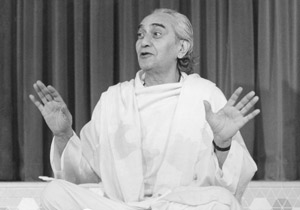 In 1971 Swami Rama founded the Himalayan International Institute of Yoga Science and Philosophy in order to create the means to scientifically verify, document, publish, and teach the experiences of his ancient heritage. He said, “We must build a center of life which will be an important bridge between East and West.” The faculty of the Institute is a team of physicians, psychologists, and spiritual thinkers trained by Swami Rama to synthesize the ancient teachings of the East and the modern technology of the West. Under Swami Rama’s expert guidance, the faculty and staff of the Institute have realized in concrete terms the projects that he proposed.
In 1971 Swami Rama founded the Himalayan International Institute of Yoga Science and Philosophy in order to create the means to scientifically verify, document, publish, and teach the experiences of his ancient heritage. He said, “We must build a center of life which will be an important bridge between East and West.” The faculty of the Institute is a team of physicians, psychologists, and spiritual thinkers trained by Swami Rama to synthesize the ancient teachings of the East and the modern technology of the West. Under Swami Rama’s expert guidance, the faculty and staff of the Institute have realized in concrete terms the projects that he proposed.
The Institute is a nonprofit organization dedicated to teaching the various aspects of yoga and meditation as a means to foster the personal growth of the individual and the betterment of society. The approach is one that addresses the whole person, body, mind and spirit, in order to lead people toward happier, healthier, and more creative lives.
From its humble beginnings in a rented house in the Chicago suburb of Barrington, Illinois, the Himalayan Institute had expanded to include branch centers throughout the States, in addition to several international centers in Germany, England, Curacao, Italy, Malaysia, Singapore, Japan, and Canada. In May, 1975, the Himalayan Institute purchased its first property, located in Glenview,Illinois. In the fall of 1977, the headquarters was moved to its present location in Honesdale,Pennsylvania.
The central headquarters is on a 422-acre campus nestled in the rolling hills of the Pocono Mountains in Northeastern Pennsylvania. There, the various educational, therapeutic, research, publishing, and residential faculties of the Institute are surrounded by spectacular views of wooded hills and valleys. Approximately 200 residents and guests can be accommodated in individual rooms. In addition, classrooms and offices, medical facilities, an auditorium, a library, a bookstore, and an import gift shop, are all housed in the main building.
The Eleanor N. Dana Research Laboratory and private apartments were located in separate buildings. The grounds included an organic vegetable garden, an orchard and apiary, hiking paths through lovely woodlands, a small lake ideal for swimming and ice skating, abundant countryside for cross country skiing, and recreational facilities for tennis, handball, volleyball, and other outdoor sports.
The Himalayan Publishers press and distribution facilities produce numerous books and periodicals on holistic health, psychology, yoga, and other topics related to consciousness and physical well being. The Himalayan Institute also published Yoga International magazine.
The Honesdale facility coordinates the Institutes’ branch centers, which serve thousands annually through regular classes and seminars. The innovative programs of the Institute provide a highly respected and reliable source of information and practical training to those interested in self directed change. Self training programs include the Self Transformation Program and the Residential Program. There are also training programs for physicians, biofeedback therapists, psychologists, and other health professionals.
The Combined Therapy Program, one of the first inpatient holistic health treatment programs in the country, was a vital part of the work of the Institute. This program had been a model for holistic health care for nearly twenty years. Based on the principle that each individual possesses the responsibility and the tools to regulate his or her own well being, the CRX combined biofeedback, hatha yoga, aerobic exercise, nutrition, breathing and relaxation skills, and meditation and self awareness techniques to provide a unique, innovative, and comprehensive approach to the treatment of chronic disease.

